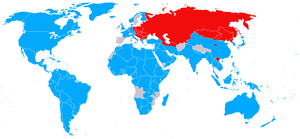- Operation Unthinkable
-
 Territory of the western Allies (blue) and Soviet Union and its allies (red) in September 1945.[citation needed]
Territory of the western Allies (blue) and Soviet Union and its allies (red) in September 1945.[citation needed]
Operation Unthinkable was a British plan to attack the Soviet Union. The creation of the plan was ordered by British Prime Minister Winston Churchill in 1945 and developed by the British Armed Forces' Joint Planning Staff at the end of World War II in Europe.
Contents
Offensive operations
The initial primary goal of the operation was declared as follows: "to impose upon Russia the will of the United States and the British Empire. Even though 'the will' of these two countries may be defined as no more than a square deal for Poland, that does not necessarily limit the military commitment" [1] (The word "Russia" is used heavily throughout the document, as during the Imperial period the term was used as pars pro toto for the Czarist Empire, with which the USSR was almost coterminous.)
The Chiefs of Staff were concerned that given the enormous size of Soviet forces deployed in Europe at the end of the war, and the perception that the Soviet leader Joseph Stalin was unreliable, there existed a Soviet threat to Western Europe. The Soviet Union had yet to launch its attack on Japan, and so one assumption in the report was that the Soviet Union would instead ally with Japan if the Western Allies commenced hostilities.
The plan was taken by the British Chiefs of Staff Committee as militarily unfeasible due to a three-to-one superiority of Soviet land forces in Europe and the Middle East, where the conflict was projected to take place. The majority of any offensive operation would have been undertaken by American and British forces, as well as Polish forces and up to 100,000 surrendered German Wehrmacht soldiers. Any quick success would be due to surprise alone. If a quick success could not be obtained before the onset of winter, the assessment was that the Allies would be committed to a total war which would be protracted. In the report of 22 May 1945, an offensive operation was deemed "hazardous".
Defensive operations
In response to an instruction by Churchill of 10 June 1945 a follow up report was written concerning "what measures would be required to ensure the security of the British Isles in the event of war with Russia in the near future".[2] United States forces were relocating to the Pacific Theatre to prepare for the invasion of Japan, and Churchill was concerned that this reduction in supporting forces would leave the Soviets in a strong position to take offensive action in Western Europe. The report concluded that if the United States focused on the Pacific theatre, Great Britain's odds "would become fanciful."[3]
The Joint Planning Staff rejected Churchill's notion of retaining bridgeheads on the continent as having no operational advantage. It was envisaged that Britain would use its air force and navy to resist, although a threat from mass rocket attack was anticipated, with no means of resistance except for strategic bombing.
Subsequent discussions
By 1946 tensions and conflicts were developing between capitalist and communist areas of Europe. These were seen as being potential triggers for a wider conflict. One such area was the Julian March, and on 30 August 1946 informal discussions took place between the British and US Chiefs of Staff concerning how such a conflict could develop and the best strategy for conducting a European war.[4] Again the issue of retaining a bridgehead on the continent was discussed, with Dwight D. Eisenhower preferring a withdrawal to the Low Countries, rather than Italy, for their proximity to the United Kingdom.
References
- ^ "Operation Unthinkable report – page 1". History.neu.edu. http://web.archive.org/web/20101116160624/http://www.history.neu.edu/PRO2/pages/002.htm. Retrieved 19 May 2011.
- ^ "Annex to Operation Unthinkable report – page 1". History.neu.edu. http://web.archive.org/web/20101116160624/http://www.history.neu.edu/PRO2/pages/030.htm. Retrieved 19 May 2011.
- ^ http://web.archive.org/web/20101116160324/http://www.history.neu.edu/PRO2/pages/024.htm
- ^ "Telegram from Washington to Cabinet Office, August 1946, headed Unthinkable". History.neu.edu. http://web.archive.org/web/20101116160624/http://www.history.neu.edu/PRO2/pages/035.htm. Retrieved 19 May 2011.
External links
- British War Cabinet, Joint Planning Staff, Public Record Office, CAB 120/691/109040 / 002 (11 August 1945). "Operation Unthinkable: 'Russia: Threat to Western Civilization'" (online photocopy). Department of History, Northeastern University. http://web.archive.org/web/20101116160624/http://www.history.neu.edu/PRO2/. Retrieved 9 May 2006.
- Bob Fenton: The secret strategy to launch attack on Red Army Telegraph, Issue 1124, 1 October. 1998
- Julian Lewis: Changing Direction: British Military Planning for Post-war Strategic Defence, 2nd edn., Routledge, 2008, pp.xxx-xl (ISBN 0-415-49171-1)
Categories:- Cancelled military operations involving the United Kingdom
- Cancelled military operations involving the United States
- Cold War military history of the United Kingdom
- Soviet Union–United Kingdom relations
- Cold War
- Cancelled invasions
Wikimedia Foundation. 2010.

